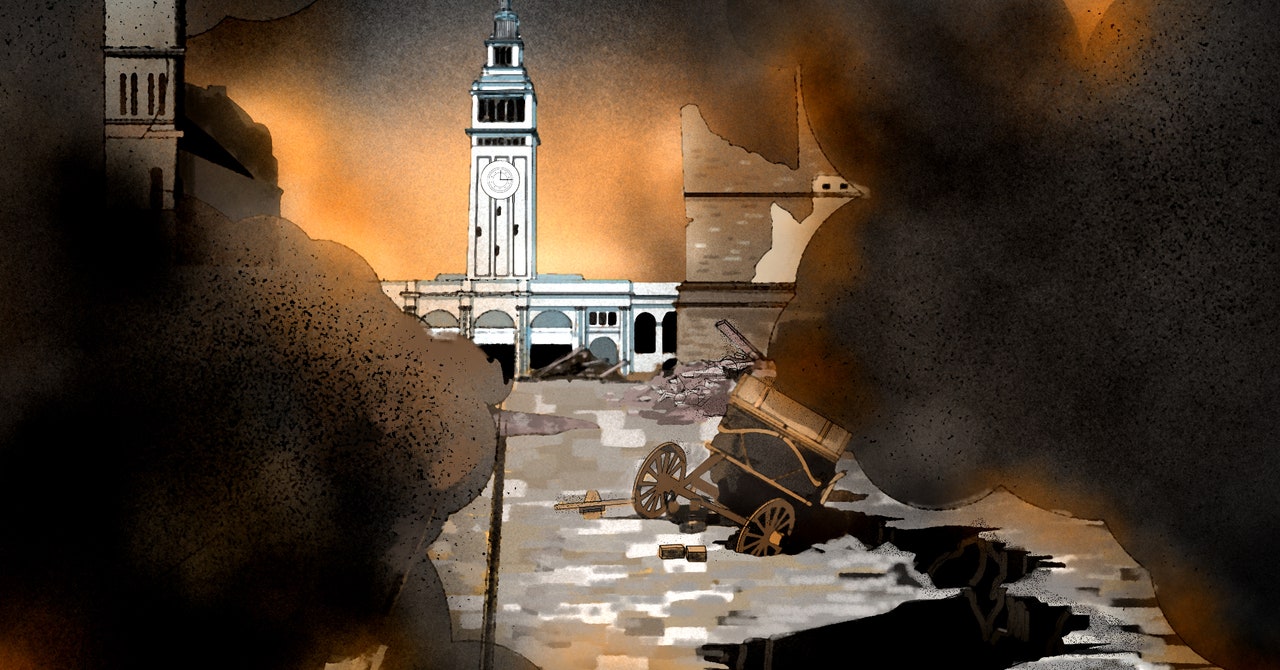
Let’s say you want to go on a walking tour of San Francisco at its warmest and most energetic. You want to see the port town after the rush for gold swelled the foggy backwater into the largest city west of the Mississippi—back when it was home to the West Coast’s tallest buildings and beautiful brick architecture. You want to see San Francisco as it was before the Golden Gate Bridge sutured California’s great gap, back when escaping the peninsula meant waiting for the ferry.
So you travel back to April 18, 1906, and with a big day ahead, you arrive in the early morning hours, while most of the city still sleeps and gas-powered lamps provide the only light.
Because you’ve done your research, you begin your tour at the location of the city’s founding: Mission San Francisco de Asís, also known as the Mission Dolores, established when the Spanish missionary Francisco Palóu arrived on the sandy, hilly, isolated peninsula in 1776.
When Francisco named the church, he did so after nearby Dolores Creek. This may surprise you, because you don’t see a creek. But the old creek bed is there, under the foundations of the churches and stockyards and houses, buried beneath a mixture of sod and trash infill thrown into the marshy area by pioneers so they could build on top of it. As you’re absorbing the scene, at exactly 5:12 in the morning, you feel a sharp, sudden jolt beneath your feet.
It’s startling.
It’s harmless.
It’s a warning.
You need to run.
The jolt is a foreshock. It’s the first wave of energy passing through the earth’s crust that presages the main event, which in this case is the biggest earthquake to ever hit a major US city. Survivor testimony suggests the foreshock arrived approximately 30 seconds before the real shaking began, which means you have roughly 30 seconds to find shelter before a 7.9-magnitude earthquake slams into a city woefully unprepared for it. Many buildings collapse. Nearly every structure sustains serious damage. Bricks, church steeples, balconies, and towers shower down on the streets below. Water mains burst. Gas lines explode, and nearly everything not shaken to the ground burns in a four‑day firestorm. In terms of lives lost in American natural disasters, the 1906 quake compares only to the 1900 hurricane in Galveston, Texas. In terms of economic damage, there is no comparison. Over the next four days, three-quarters of the city crumbles into rubble and ash. At least 200,000 people are left homeless. More than 3,000 die.
But all that comes later.
When you feel the foreshock you need to get off the street, because you’re surrounded by buildings of dubious construction with foundations wobbling atop an old pioneer trash pit. But oddly, the safest course of action is to get inside one. The only place more dangerous than inside a wobbly building is beside one, because in 30 seconds nearly every chimney, church spire, and cupola in the city will collapse onto the streets below.
Of course, you shouldn’t just run into any building. Use your 30 seconds and survey your options: Barns, factories, stockyards, and other structures with large open spaces and few interior walls are more likely to collapse than buildings designed for living. (In 1906, nearly every warehouse in San Francisco collapsed.) Instead, look for houses, offices, or apartments—anything with lots of interior walls.
Avoid brick buildings and the structures next to them. Unlike wood-framed constructions, brick buildings shatter rather than sway, and they often shed walls instead of collapsing, saving those inside them but posing huge risks to those beneath. Many of the fatalities, including San Francisco fire chief Dennis Sullivan, occurred when a building collapsed onto the roof next door.

